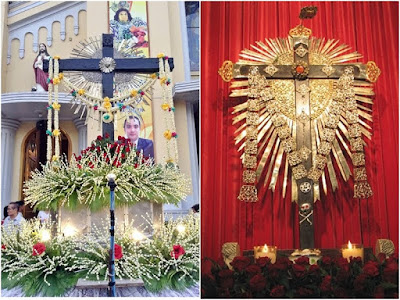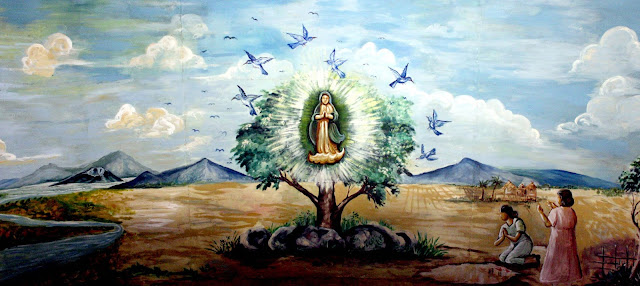The Holy Crosses of Tunasan and Matahong - The Crosses in Rizal's "Noli Me Tangere"
 |
| The Holy Crosses of Tunasan (Left) and Matahong (Right) |
 |
| The Crosses of Tunasan (background) and Matahong (foreground) |
The Two Crosses
The images of the Crosses of Tunasan and Malabon have some similar features: the dark color of the Cross, the metal rayos on the inner sections of the Cross and other metal accessories that are decorated in the Crosses. The only difference of the two Crosses are the Cross of Tunasan was taller by a few feet than the one in Matahong.
 |
| One of the early copies of "Noli me Tangere" |
In the Forty second chapter of Rizal's "Noli me Tangere" entitled "Ang Mag-asawang De Espadaña" Rizal wrote in his novel about Maria Clara, the love interest of the novel's protagonist Crisostomo Ibarra, who got sick with fever and his step father Santiago delos Delos Santos, or Kapitan Tiago and her aunt Isabel were arguing to which cross they should gives alms from the growing Cross of Tunasan or the sweating Cross of Matahong.
"Malungkot sa bahay ni Kapitan Tiyago sapagkat may sakit si Maria. Pinag-uusapan ng magpinsang Tiya Isabel at Kapitan Tiyago kung alin ang mabuting bigyan ng limos, ang krus sa Tunasan na lumaki, o ang krus sa Matahong na nagpapawis. Nais malaman ni Tiyago kung alin sa dalawang ito ang higit na mapaghimala. Napagdesisyonan na parehong bigyan ng limos ang dalawang ito upang gumaling kaagad ang karamdaman ni Maria. Natigil ang pag-uusap ng magpinsan nang mayroong tumigil sa harap ng bahay."
 |
| The growing Cross of Tunasan |
The origins of the Cross of Tunasan is uncertain for there were scarce records on how this Cross arrived or appeared in San Pedro, Laguna. However, legends surrounding its arrival varies, from its sudden apparition from some unknown barrio in San Pedro, Laguna to its creation by some hermit of the area, some even claims that it came straight from heaven. Its one of those images that represented time and people, one could not tell a story about the small town without suggesting to see it for a visit to San Pedro Tunasan during the old days is incomplete without touching its base.
Its miraculous healing powers became popular during the epidemic years in the town, were countless of towns folk sought divine healing from the deadly diseases that ravaged the once rustic town. It’s also a silent witness to the transformation of the small town from a Sampaguita plantation and a narrow passage to the richer Laguna towns to what it is now, a residential and industrial urban municipality. It survived both natural and man made disasters – during this difficult years the older generation of San Pedro knelt in front of the miraculous cross and prayed for a better future.
However, with the urbanization of the San Pedro City, consequently, the devotion to the Holy Cross of Tunasan went into oblivion with numerous renovations that undertook in its home Church - the St. Peter the Apostle Parish over the years and the Cross was moved from a different place to another and focusing on celebrating of the Feast of its Titular Patron, St. Peter the Apostle. Fortunately, efforts to revive the devotion to the Cross of Tunasan came in the recent years with the recent revival of its procession last 2016 and the Cross was later moved to its own altar for veneration of the faithful.
 |
| The sweating Cross of Matahong |
The Holy Cross of Matahong was one of the most revered images of Malabon. Folks recall that the image made known its presence in 1813 when the image was seen floating in a river.by the people. The image was said to be made from the a broken chair. Over time, the people noticed that the Cross began to emit oil or at times sweat and cures were reported through the help of the Holy Cross of Matahong.
The Holy Cross of Matahong gained much devotion in Malabon that its popularity reached outside Malabon. The devotees flock his makeshift visita when the family sets up the hut of the Cross for the Santa Cruzan of the City. During the devastating years of World War 2, the devotions and the traditions surrounding the Holy Cross came to a screeching halt yet it resumed years after the War.
At Present, the Cross of Matahong is currently at the custody of the children of its original caretakers for safe keeping and it will be exposed for public veneration on the month of May for the Santacruzan tradition in the hut chapel that is located in Calle Matahong in Malabon. The image was also brought to San Bartolome Parish in Malabon and San Lorenzo Ruiz Parish in Navotas for public veneration.
 |
| The meeting of the two Miraculous Crosses |
For some reason, some of our faithful doubted the existence of the two Crosses that are mentioned in the novel for unknown reasons and the doubts were silenced on May 17, 2009, for the first time since the publication of Jose Rizal's "Noli Me Tangere", the two aforementioned Crosses met for the first time in centuries for the celebration of the anniversary of San Bartolome Parish in Malabon. The meeting of the two crosses further ignited the devotion to the two miraculous Crosses and both shrines find themselves flocked with pilgrims over the years and miracles continues to be experienced by its devotees through the help of these centuries old Crosses.
The Cross is the greatest symbol of Christianity because of what it represents: Christ's life-giving sacrifice and victory over death. We use the Cross in our devotions from the Sign of the Cross, the Way of the Cross, Veneration of the Cross among others. Christ implored, “He who does not take up his cross and follow me is not worthy of me. He who finds his life will lose it, and he who loses his life for my sake shall find it” (Mt 10:38,39). Keeping the Cross visible in our lives helps us to meditate on his Passion and Death, and gives us hope for everlasting life.





Correction: San Pedro Tunasán is no longer a municipality but a city.
ReplyDeleteGood day, Thank you for updating the status of the city. The necessary corrections were already made. Thank you!
Delete